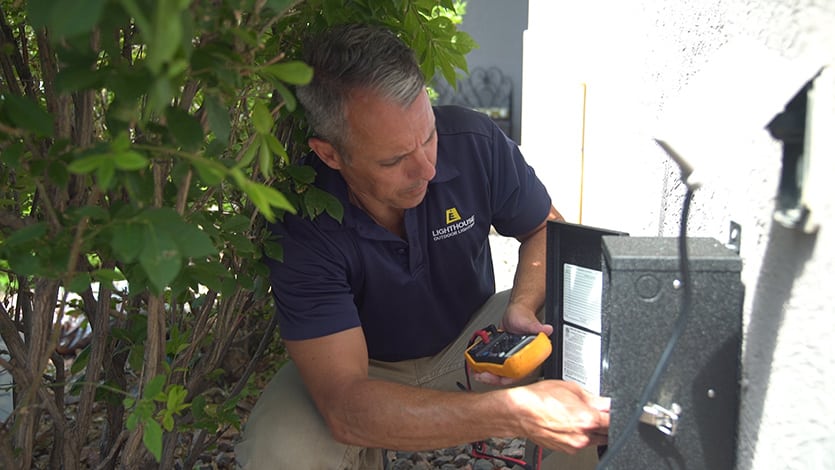When you meet with a certified, Lighthouse Outdoor Lighting® designer, you can rest assured that they are going to ask all the right questions and listen to make sure they understand your needs, desires and expectations.
One of the questions they will ask you is, “How would you like your lights to operate?” In the world of lighting, this is what we call lighting controls. Lighting controllers can range from very simple automatic functions, to very complex auto/manual control.
This article will explain the differences, so you will have a better understanding of the right controller for you.
There are 4 basic types of controllers: Analog, digital, photovoltaic and Wi-Fi based controls. Below is a brief explanation of each.
ANALOG TIMERS
These types of controllers have been around the longest and are very simplistic. The controller will generally consist of a small plastic module with a 24-hour clock dial. Around the outside of the dial will usually be a series of push/pull pins that you either push in to indicate ON times or that you pull out to indicate OFF times. This allows you to simply and visually assign as many ON/OFF times as you like in the 24-hour cycle.
The benefit of this controller is that it is incredibly easy to set, however this controller only operates when it is given direct, 120v power. If the power goes out for one reason or another, the controller will need to be manually reset to the current time to maintain the correct schedule.
DIGITAL ASTRONOMIC TIMERS
Digital control devices will be similar in size to the analog timers, so that they also fit neatly and are concealed within the Lighthouse power center. However, this is where the similarities end. Instead of a manual dial for setting the time and control functions, all the programing is entered via a menu on a digital display.
The benefit of these controllers is that they have a battery back-up that holds the time and programming in the event of a short power failure, so you will not have to reset them.
They also have astronomic functions, which means they will function much like a photocell control and will turn on automatically at dusk and off again at dawn. The astronomic functions work based on the inputs of day-date-time- time zone as well as the latitude and longitude of your home. The On/Off times will automatically adjust roughly a minute every day to correspond to the changing sunrise/sunset schedule throughout the year.
They also automatically adjust for daylight savings time when appropriate. This is essentially a set it and forget it controller.
PHOTOCELL CONTROL
Photocells have been around almost about as analog timers. In the right situation, there is not a simpler and more reliable control device available for simple On/Off automatic control operation of your outdoor lights.
Photocells work based solely on the degree of light that the internal sensor receives. If the light hitting the sensor exceeds a certain level, the control will open the circuit, thereby shutting off power to the lighting. Inversely, when the ambient light level to the sensor drops below a certain threshold, the photocell will close the circuit and the lights will turn on.
The only down side of photo cells is that they must be placed outside with a clear view of the open sky. Dark, heavily wooded areas can get dark on cloudy days causing the photocell to activate and waste electricity.
They can also be problematic if they are placed too close to other ambient light sources that can cause them to continually cycle on and off. The beautiful thing about photocells is that they never need to be reset if there is a power failure. They are the perfect controller for anyone seeking simple dusk to dawn operation.
WIFI CONTROLLERS
These types of controllers are generally operated via a smart phone or another app based digital tablet. The functionality of these devices can range from simple astronomic functionality to much more advanced controls that allowing remote dimming of individual fixtures or groups of fixtures, zone controls that allow a homeowner to establish themes for different times of the night or different events such as outdoor parties or more subdued, intimate settings.
Many of the new controllers even allow for color changing control when using luminaires with RGBW (Red, Green, Blue, White) LED chipsets. These types of controllers require an upgraded lighting system that have light fixtures with a much more robust set of electronics on-board.
These advanced lighting systems are perfect for those who desire a much greater level of lighting control for their outdoors and have the budget to make it happen.

